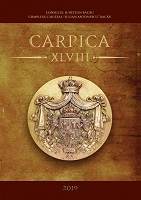Examining charcoal samples collected from the tumular cemeteries of Târzia and Braniște-Nemțișor
Examining charcoal samples collected from the tumular cemeteries of Târzia and Braniște-Nemțișor
Author(s): Ionel A. LupuSubject(s): Archaeology, Cultural history, Ancient World
Published by: Complexul Muzeal “Iulian Antonescu” Bacău
Keywords: tumuli; cremation; charcoal; „Carpathian tumuli culture”; arboreal landscape; wooden species;
Summary/Abstract: Two important ancient cemeteries were researched between 1974 and 1992 in the villages Târzia (Brusturi commune) and Nemțișor – at Braniște (Vânători-Neamț commune) both of them situated in Neamț county. The respective necropoleis consisted of tumulii (hillock), which were covering the rests of some funerary stakes on which the deceased were burnt. The cemeteries from Târzia and Braniște-Nemțișor have been attributed to „Carpathians tumuli culture” and date between the end of the 3rd century AD and the end of the following one (4th century AD). As a consequence of the above mentioned cremation, different materials resulted, among them being charcoal, which were taken in order to determine the species existing in the mentioned period. Thus, it was intended the reconstitution of the arboreal landscape of the region and, therefore, of the climatic conditions of that time. There could not be investigated the whole quantity of charcoal resulted from the archaeological excavations. Only some samples have been determined, among them the complete study of the funerary complex (no. 1) from the tumulus no. 3 of Târzia and especially of the tumulus no. 32 from Braniște-Nemțișor which was entirely analyzed. The charcoal samples from the necropolis of Târzia revealed the utilization of the sixteen species of wood and shrubs during the funerary ceremonies (table no. 1). In the cemetery of Braniște-Nemțișor 21 species of trees and shrubs have been identified (Table no. 2). As a result of the research of the charcoal taken from the two cemeteries mentioned above, the following remarks can be done: 26 species have been noticed in the two necropoleis, 11 of them being common; the species from the temporal sequence in matter can still be found nowadays in the same geographical area; the species mostly used as a fuel was the beech wood often associated with spruce and fir; some of them seem to have had a certain destination, probably a ritual one: Hazel (Corylus avellana L.), Juniper (Juniperus communis L.), and also, probably, the Creeping pine (Pinus mugo ssp. mughus Mill.) and Alpine azalea (Loiseleuria procumbens (L.) Desv.); identifying certain wooden species one can presume that in geographical zone and in the period of time when the cemeteries from Târzia and Braniște-Nemțișor can be placed, there was a cooler and droughty climate than the present one.
Journal: Carpica
- Issue Year: 2020
- Issue No: XLIX
- Page Range: 119-129
- Page Count: 11
- Language: English

